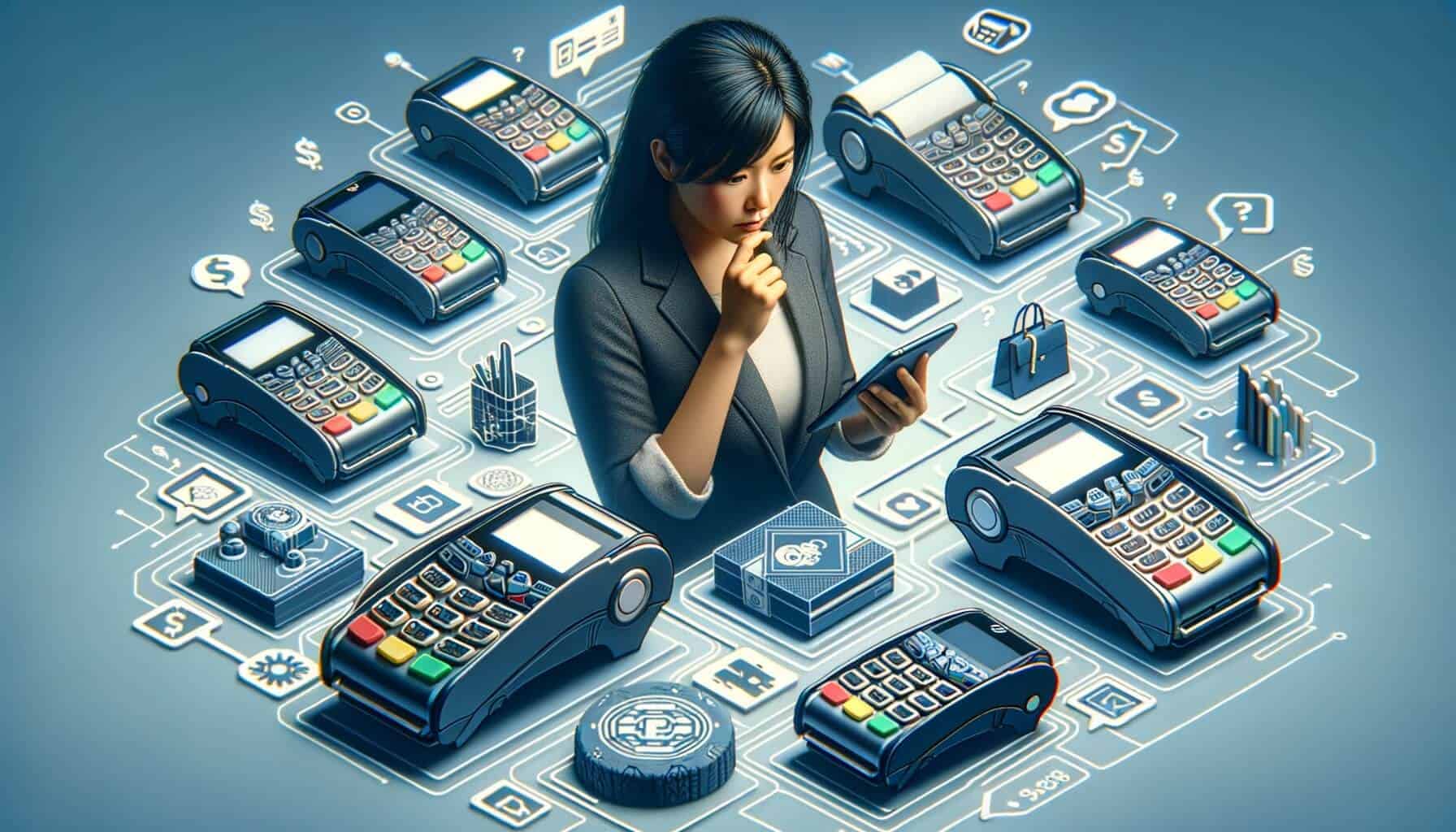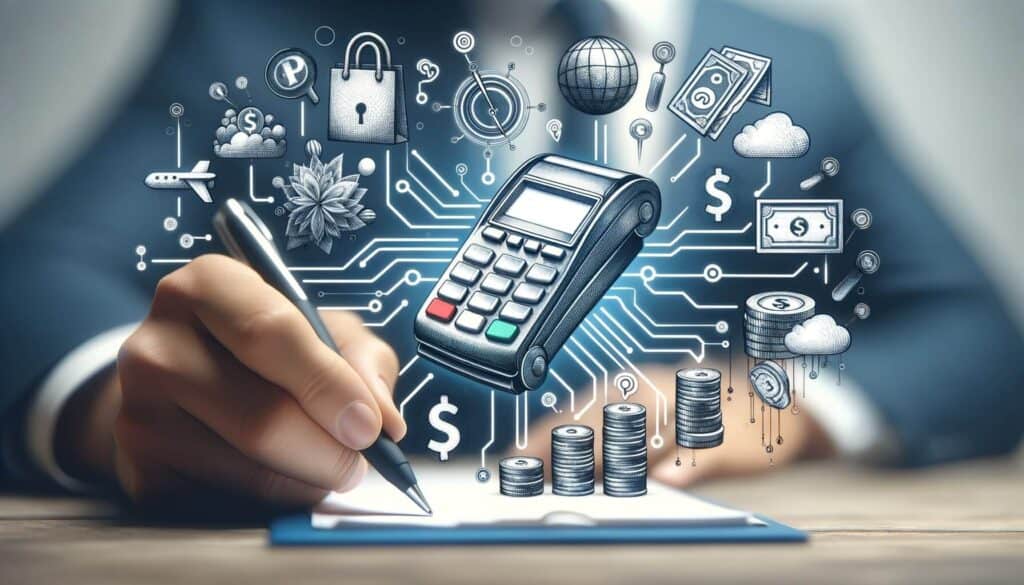
By American April 3, 2025
In today’s digital age, having a reliable and efficient payment terminal is crucial for any business. Whether you run a small retail store or a large restaurant chain, the payment terminal you choose can significantly impact your customers’ experience and your overall business operations. With numerous options available in the market, selecting the best payment terminal for your business can be a daunting task.
This comprehensive guide will walk you through the factors to consider, types of payment terminals, security features, compatibility and integration options, costs and fees, choosing the right payment terminal provider, setting up and installing your payment terminal, troubleshooting common issues, and frequently asked questions. By the end of this article, you will have a clear understanding of how to select the best payment terminal for your business.
Factors to Consider When Selecting a Payment Terminal for Your Business
When choosing a payment terminal for your business, it is essential to consider several factors to ensure that it meets your specific needs and requirements. Here are some key factors to consider:
1. Business Type and Size: The type and size of your business play a significant role in determining the payment terminal that suits you best. For instance, if you run a small retail store, a countertop terminal may be sufficient. However, if you operate a mobile business or frequently attend trade shows, a wireless or mobile payment terminal would be more suitable.
2. Payment Methods: Consider the payment methods you want to accept. While most payment terminals support credit and debit cards, some may also offer contactless payments, mobile wallets, or even cryptocurrency options. Ensure that the payment terminal you choose supports the payment methods your customers prefer.
3. Connectivity Options: Payment terminals can be connected via various methods, including Ethernet, Wi-Fi, or cellular networks. Evaluate the available connectivity options and choose one that aligns with your business’s infrastructure and location.
4. User-Friendliness: A user-friendly payment terminal is essential for both your staff and customers. Look for terminals with intuitive interfaces, easy-to-read screens, and straightforward navigation. This will minimize training time for your employees and provide a seamless experience for your customers.
5. Integration with Existing Systems: If you already have a point-of-sale (POS) system or other business management software in place, ensure that the payment terminal you choose can integrate seamlessly with these systems. This integration will streamline your operations and eliminate the need for manual data entry.
6. Customer Support: Consider the level of customer support provided by the payment terminal provider. Look for a provider that offers 24/7 technical support, regular software updates, and troubleshooting assistance. This will ensure that any issues or concerns are promptly addressed, minimizing downtime and disruptions to your business.
7. Pricing and Contracts: Evaluate the pricing structure and contract terms offered by different payment terminal providers. Look for transparent pricing with no hidden fees, and consider the length of the contract and any cancellation fees. It is crucial to choose a provider that offers fair and competitive pricing without compromising on quality and service.
8. Scalability: Consider the future growth and expansion plans of your business. Choose a payment terminal that can accommodate your business’s growth and easily scale up to meet increasing transaction volumes.
9. Reputation and Reviews: Research the reputation and customer reviews of different payment terminal providers. Look for providers with a solid track record, positive customer feedback, and a strong presence in the industry. This will give you confidence in the reliability and quality of their products and services.
10. Security and Compliance: Security is of utmost importance when it comes to payment terminals. Ensure that the terminal you choose complies with the Payment Card Industry Data Security Standard (PCI DSS) and offers advanced security features such as encryption and tokenization. This will protect your customers’ sensitive payment information and minimize the risk of data breaches.
Types of Payment Terminals: A Comprehensive Overview
Payment terminals come in various types, each catering to different business needs and environments. Understanding the different types of payment terminals will help you choose the one that best suits your business. Here are the most common types of payment terminals:
1. Countertop Terminals: Countertop terminals are the traditional payment terminals that are typically placed on a counter or checkout desk. They are connected to a power source and a phone line or internet connection. Countertop terminals are suitable for businesses with a fixed location, such as retail stores, restaurants, and salons. They offer a reliable and secure way to process payments and usually have a built-in receipt printer.
2. Wireless Terminals: Wireless terminals, also known as portable terminals, offer the flexibility to accept payments anywhere within the range of a wireless network. They are ideal for businesses that require mobility, such as food trucks, delivery services, and trade show vendors. Wireless terminals connect to a base station or router wirelessly and provide the convenience of accepting payments on the go.
3. Mobile Payment Terminals: Mobile payment terminals are designed to work with smartphones or tablets, turning them into portable payment devices. They connect to the mobile device via Bluetooth or a physical connection and use a mobile app to process payments. Mobile payment terminals are popular among small businesses, independent contractors, and service providers who need a cost-effective and portable payment solution.
4. Virtual Terminals: Virtual terminals allow businesses to accept payments online or over the phone. They are accessed through a web browser and do not require any physical hardware. Virtual terminals are suitable for businesses that primarily operate online or have a significant phone order component, such as e-commerce stores, call centers, and subscription-based services.
5. Self-Service Kiosks: Self-service kiosks are interactive terminals that allow customers to make payments themselves without the assistance of a staff member. They are commonly used in industries such as retail, hospitality, and healthcare. Self-service kiosks offer convenience and efficiency, reducing wait times and improving customer satisfaction.
Evaluating the Security Features of Payment Terminals
Security is a critical aspect of payment terminals, as they handle sensitive customer payment information. When evaluating the security features of payment terminals, consider the following:
1. Encryption: Encryption is the process of converting sensitive data into unreadable code to prevent unauthorized access. Look for payment terminals that support end-to-end encryption, which ensures that payment data is encrypted from the moment it is entered into the terminal until it reaches the payment processor. This protects customer data from interception and reduces the risk of data breaches.
2. Tokenization: Tokenization replaces sensitive payment data with a unique identifier called a token. The token is used for transaction processing, while the actual payment data is securely stored in a token vault. Tokenization adds an extra layer of security by ensuring that sensitive data is not stored within the payment terminal or merchant’s system, making it useless to hackers in the event of a breach.
3. EMV Compliance: EMV (Europay, Mastercard, and Visa) is a global standard for secure payment transactions using chip-enabled cards. EMV-compliant payment terminals have a slot or contactless reader that can process chip cards, reducing the risk of counterfeit card fraud. Ensure that the payment terminal you choose is EMV compliant to protect your business from liability in case of fraudulent transactions.
4. Point-to-Point Encryption (P2PE): Point-to-Point Encryption is a security measure that encrypts payment data from the moment it is captured by the payment terminal until it reaches the payment processor. P2PE ensures that sensitive data is protected throughout the entire transaction process, minimizing the risk of data breaches and unauthorized access.
5. PCI DSS Compliance: The Payment Card Industry Data Security Standard (PCI DSS) is a set of security standards designed to protect cardholder data. Ensure that the payment terminal you choose is PCI DSS compliant, meaning it meets the industry’s security requirements and undergoes regular security audits. PCI compliance ensures that your business is handling payment data securely and reduces the risk of penalties and fines.
6. Secure PIN Entry: If your business accepts debit card payments, ensure that the payment terminal has a secure PIN pad for customers to enter their PINs. Look for features such as tamper resistance, shielded PIN entry, and secure key management to protect against PIN theft and unauthorized access.
7. Fraud Detection and Prevention: Some payment terminals offer advanced fraud detection and prevention features, such as real-time transaction monitoring, velocity checks, and geolocation verification. These features help identify and prevent fraudulent transactions, protecting your business and customers from financial losses.
Assessing the Compatibility and Integration Options of Payment Terminals
When selecting a payment terminal for your business, it is crucial to assess its compatibility and integration options with your existing systems. Here are some key considerations:
1. Point-of-Sale (POS) Integration: If you already have a POS system in place, ensure that the payment terminal can seamlessly integrate with it. Integration allows for automatic synchronization of sales data, inventory management, and reporting, eliminating the need for manual data entry and streamlining your operations.
2. E-commerce Integration: If you operate an online store or plan to expand your business to the online realm, consider a payment terminal that integrates with popular e-commerce platforms or payment gateways. This integration will enable you to accept online payments and provide a consistent payment experience across different channels.
3. Accounting Software Integration: If you use accounting software to manage your business finances, look for payment terminals that integrate with your accounting software. Integration allows for automatic synchronization of transaction data, simplifying your bookkeeping and reducing the risk of errors.
4. Customer Relationship Management (CRM) Integration: If you use a CRM system to manage customer data and relationships, consider a payment terminal that integrates with your CRM. Integration allows for automatic updating of customer profiles with transaction data, providing valuable insights and enabling personalized marketing and customer service.
5. Third-Party App Integration: Some payment terminals offer the flexibility to integrate with third-party apps and services, such as loyalty programs, inventory management systems, or marketing tools. Assess your business needs and consider the availability of app integrations that can enhance your operations and customer experience.
Understanding the Costs and Fees Associated with Payment Terminals
When selecting a payment terminal for your business, it is essential to understand the costs and fees associated with it. Here are the key cost factors to consider:
1. Terminal Cost: The upfront cost of the payment terminal itself can vary depending on the type and features. Countertop terminals are generally more affordable, while wireless and mobile terminals may have a higher price tag due to their added mobility and functionality. Consider your budget and the specific needs of your business when evaluating terminal costs.
2. Transaction Fees: Transaction fees are charged for each payment transaction processed through the payment terminal. These fees can be a flat rate or a percentage of the transaction amount. Compare the transaction fees offered by different payment terminal providers and consider the average transaction volume of your business to estimate the overall cost.
3. Monthly Fees: Some payment terminal providers charge monthly fees for the use of their services and support. These fees may cover customer support, software updates, and access to reporting and analytics tools. Evaluate the monthly fees and consider the value and level of service provided to determine if they are reasonable for your business.
4. Setup and Installation Fees: Some payment terminal providers may charge setup and installation fees to cover the initial configuration and onboarding process. These fees can vary depending on the complexity of your business requirements and the level of support provided. Consider the setup and installation fees when evaluating the overall cost of the payment terminal.
5. Maintenance and Support Fees: Maintenance and support fees may be charged by payment terminal providers to cover ongoing technical support, software updates, and hardware maintenance. These fees ensure that your payment terminal remains up-to-date and functioning optimally. Evaluate the maintenance and support fees and consider the level of service provided to determine if they are justified.
6. Cancellation Fees: Some payment terminal providers may have cancellation fees if you decide to terminate the contract before its expiration. These fees can vary depending on the remaining contract term and the provider’s policies. Consider the cancellation fees when evaluating the long-term commitment and flexibility of the payment terminal provider.
7. Additional Features and Add-Ons: Some payment terminal providers offer additional features and add-ons that can enhance the functionality of your payment terminal. These may include features such as inventory management, loyalty programs, or advanced reporting tools. Assess the value and cost of these additional features and consider if they align with your business needs and budget.
Choosing the Right Payment Terminal Provider: Key Considerations
Selecting the right payment terminal provider is as important as choosing the payment terminal itself. Here are some key considerations when evaluating payment terminal providers:
1. Reputation and Experience: Research the reputation and experience of different payment terminal providers. Look for providers with a proven track record, positive customer reviews, and a strong presence in the industry. A reputable provider is more likely to offer reliable products and services and provide excellent customer support.
2. Customer Support: Consider the level of customer support provided by the payment terminal provider. Look for providers that offer 24/7 technical support, multiple support channels (phone, email, live chat), and a dedicated account manager. Prompt and reliable customer support is crucial to minimize downtime and ensure smooth operations.
3. Scalability and Flexibility: Assess the scalability and flexibility offered by the payment terminal provider. Consider if they can accommodate your business’s growth and easily scale up to meet increasing transaction volumes. Additionally, evaluate if they offer flexible contract terms and the ability to upgrade or downgrade your payment terminal as needed.
4. Integration Capabilities: If you have existing systems in place, such as a POS system or accounting software, ensure that the payment terminal provider can seamlessly integrate with them. Integration capabilities will streamline your operations and eliminate the need for manual data entry.
5. Security and Compliance: Security should be a top priority when evaluating payment terminal providers. Ensure that they comply with industry security standards, such as PCI DSS, and offer advanced security features such as encryption and tokenization. Additionally, assess their data protection policies and measures to ensure the safety of your customers’ payment information.
6. Pricing and Contracts: Evaluate the pricing structure and contract terms offered by different payment terminal providers. Look for transparent pricing with no hidden fees, and consider the length of the contract and any cancellation fees. It is crucial to choose a provider that offers fair and competitive pricing without compromising on quality and service.
7. Payment Processing Options: Consider the payment processing options offered by the payment terminal provider. Look for providers that offer competitive transaction rates, support for various payment methods, and fast and reliable transaction processing. The provider should have partnerships with major payment processors to ensure seamless payment processing.
Step-by-Step Guide: How to Set Up and Install Your Payment Terminal
1. Choose the Right Terminal: Based on the factors discussed earlier, select the payment terminal that best suits your business needs.
2. Gather Required Information: Before setting up your payment terminal, gather all the necessary information, such as your business details, bank account information, and any required certifications or licenses.
3. Connect the Terminal: Follow the manufacturer’s instructions to connect the terminal to the internet. This may involve connecting via Ethernet, Wi-Fi, or cellular networks.
4. Install Software and Update Firmware: Install any required software or applications on the terminal and ensure that the firmware is up to date. This step is crucial for security and compatibility with the payment processor.
5. Configure Settings: Set up the terminal’s settings, such as language, currency, tax rates, and receipt preferences. Consult the user manual or contact customer support if you need assistance.
6. Test Transactions: Perform test transactions to ensure that the terminal is functioning correctly. Test different payment methods, such as credit cards, debit cards, and contactless payments, to verify that all options are working as expected.
7. Train Staff: Train your staff on how to use the payment terminal correctly. Provide them with clear instructions on processing transactions, handling refunds, and troubleshooting common issues.
Troubleshooting Common Issues with Payment Terminals
1. Connectivity Issues: If your payment terminal is experiencing connectivity issues, ensure that it is properly connected to the internet. Check the Ethernet or Wi-Fi connection, or if using a wireless terminal, ensure that it has a strong cellular signal.
2. Card Reading Errors: If the terminal is having trouble reading cards, ensure that the card is inserted correctly and that the chip or magnetic stripe is clean. If the issue persists, try using a different card or contact customer support for further assistance.
3. Slow Transaction Processing: Slow transaction processing can be caused by various factors, such as a slow internet connection or outdated software. Check your internet speed and ensure that the terminal’s software is up to date. If the issue persists, contact your payment terminal provider for further troubleshooting.
4. Error Messages: Error messages on the payment terminal can indicate various issues, such as invalid card information or connectivity problems. Refer to the terminal’s user manual or contact customer support for specific error code explanations and troubleshooting steps.
FAQs
1. What is the difference between a payment terminal and a POS system?
A payment terminal is a device used to accept payments, while a point-of-sale (POS) system is a comprehensive solution that includes a payment terminal, inventory management, reporting, and other features. A payment terminal is a component of a POS system.
2. Can I use my existing payment terminal with a new provider?
In some cases, you may be able to use your existing payment terminal with a new provider. However, compatibility may vary depending on the terminal and the provider. Contact your new provider to determine if your terminal can be reprogrammed or if you need to purchase a new one.
3. How long does it take to set up a payment terminal?
The time it takes to set up a payment terminal can vary depending on the complexity of the terminal and the provider’s processes. In general, it can take anywhere from a few minutes to a few hours to set up and configure a payment terminal.
4. What should I do if my payment terminal is stolen or lost?
If your payment terminal is stolen or lost, contact your payment terminal provider immediately to report the incident. They will guide you through the necessary steps to protect your business and prevent unauthorized use of the terminal.
Conclusion
Selecting the best payment terminal for your business is a critical decision that can impact your operations and customer experience. By considering factors such as your business type and size, payment methods, security, connectivity, and cost, you can make an informed choice. Additionally, choosing a reputable payment terminal provider that offers excellent customer support and additional services can further enhance your payment processing capabilities.
By following the step-by-step guide for setting up and troubleshooting common issues, you can ensure a smooth and efficient payment process for your business. Remember, investing time and effort in selecting the right payment terminal will pay off in the long run, leading to increased customer satisfaction and improved business performance.




